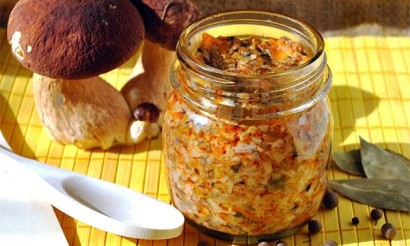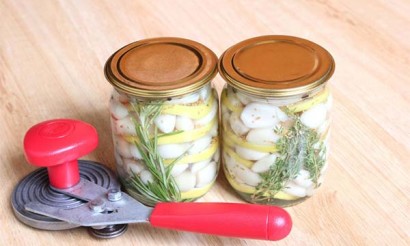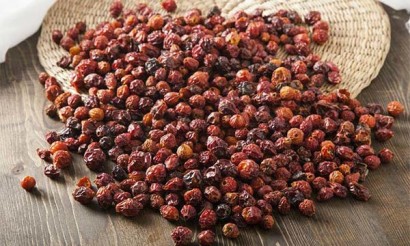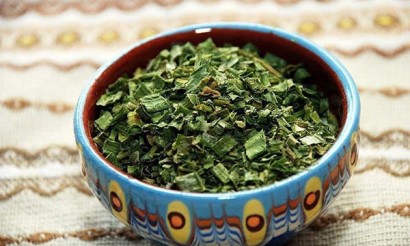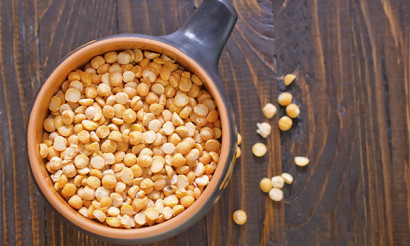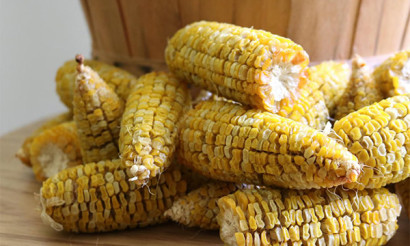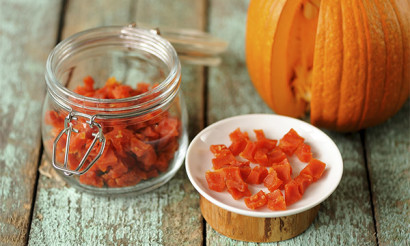How to Dry Melon Properly: 5 Ways
The fragrant, juicy melon is a great treat in the summer heat. To enjoy the incomparable taste all year round, this product is used to make jams, candied fruits, and marshmallows. Melon is a valuable source of vitamins, microelements and fiber. Among different methods of its preparation drying deserves special attention. In this form the product is stored for a long time, takes up little space and retains all its useful properties. Dried melon slices were for a long time considered an exotic delicacy. But this dessert is not difficult to prepare yourself at home.
How to choose a melon for drying
The preparation of dried melon is a long and painstaking process, the result of which largely depends on the quality of raw materials. Therefore, the selection of fruits for processing should be approached responsibly, leaving only those that perfectly meet all the criteria.
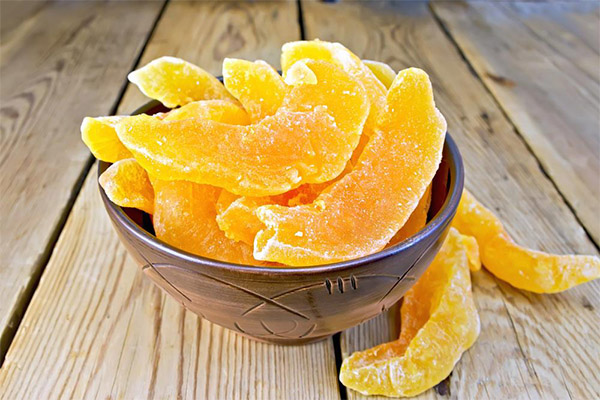
For drying are suitable hard ripe fruits with a dense flesh. Overripe specimens are better to send immediately on the table or leave for jam. So-called honey melons - very fragrant and juicy, but excessively moist - are not suitable for drying. The wonderful fruit will get moldy or rotten during cooking. Therefore, such sugar melons are better to be eaten immediately or used for making jam, compote, marshmallow.
Greenish melons are also not suitable for drying. Their slices after harvesting acquire a bitter taste, in addition, they are tough in texture. Such a fruit can be given time to ripen in a warm dry room and eaten fresh. Melons that have not ripened on the root are not suitable for drying.
There should be no dark spots, punctures, or dents on the outside. Any damage to the tissues increases the risk of rotting during cooking, so it's better not to take any chances. Even if the damaged area is cut and cleaned up, there may still be signs of impact or pockets of rot near it.
Moderately ripe, sweet gulabi or Persian melons are best dried. The more familiar ones - kolhoznitsa or torpedo - will also do, but give a less sweet product. Pineapple melon is very tasty in dried form, if you manage to find fruits suitable for such processing.
How to prepare melon for drying
To prepare the melon for cooking should be treated responsibly, the quality of the final product depends on it. The purpose of this stage is to cut the fruit into slices of the required shape and convenient size and rid them of excess moisture.
- The selected fruits are carefully washed with cool water. Despite the fact that the skin is cut off before drying, the washing ensures perfect cleanliness. Rinse the flesh is no longer allowed, so it is important that when you cut the fruit, there were no pieces of earth or dirt on it.
- The melon is cut lengthwise in half and carefully removed from the seeds. The hollow in the center of the fruit is scraped out with a knife. Carefully cut off the skin and undercrust layer.
- The flesh is cut into longitudinal slices 5-7 mm thick. If the fruit is large, you can divide large pieces into 10-15 cm long fragments. For drying on a string or wire, melon cubes of 2-4 cm are also prepared.
You can use another slicing option: cut the slices into long strips. During the drying process, when they are slightly wilted, the slices are woven into plaits or twisted into rolls. In this form bring the process of drying to an end. This method is traditional in the Middle East and Central Asia.
For drying on a wire it is convenient to make double slices. To do this, a melon slice is cut lengthwise from bottom to top by three-quarters of the length. This results in a piece that resembles the shape of the letter L. Such double slices do not need to be pierced during drying.
Sliced material is spread in a single layer on a paper, cover with gauze and leave in a darkened well ventilated room for 1-2 days. During this time, the slices are turned from one side to the other. Such preparation is necessary to get rid of excess moisture and slightly wilt the melon. If you ignore this step, then during natural drying in the sun the product will begin to get moldy, and when cooking with the use of household appliances will stick.
How to dry melon at home
With any method of drying melon is a long process, during which all the liquid from the raw material will slowly evaporate. The more natural the process, the more quality and rich in vitamins the product will be.
In the oven
The technology of melon drying in the oven does not depend on the type of stove. The sequence of operations is the same for both gas and electric devices. Connoisseurs and connoisseurs assure that it is the oven-dried melon that is the most fragrant and delicious.
- Because of the dense texture of the high sugar content of the fruit, you can not dry it on a baking tray, the product will not dry, but will burn. For the preparation take a rack, cover it with baking paper or parchment, greased with a thin layer of vegetable oil. A silicone baking mat will also work.
- On the prepared surface, lay melon slices, place the rack in the oven and turn on the heat to 120 degrees. The temperature inside the oven will rise gradually, in these conditions the drying is done gently. At the maximum level of heating, the melon is kept for about half an hour. Then the temperature is reduced to 80 degrees, and on it bring the process to an end.
- If the stove model is equipped with a convection system, it must be included, this will make the drying process more effective. In other cases, it is better to loosely close the oven door to ensure ventilation.
- The drying of melon is closely watched. If the slices become darker or burnt, turn off the oven and let it cool completely. The pieces of pulp are turned to the other side, and the tray is moved to another level. Later, the oven is turned on again and continues the process until it is complete.
With this method of preparation you can sprinkle the slices with sugar, especially if you have chosen a moderately sweet fruit for drying.
The whole process will take 4-6 hours, depending on the type of oven and the juiciness of the raw material. Before wrapping the finished product, it is allowed to cool completely. For this time, cover the slices with gauze or a thin cloth and leave in a well-ventilated room.
In an electric dryer
Carousel dryers are perfect for making melon. Prepared slices are laid out in a single layer on trays. Adding sugar to this method of preparation should not be done, it can spoil the electric device. Depending on the model of the device, select the mode "Vegetables", "Vegetables and fruits" or set the temperature to 65-70 degrees. Every 1-2 hours the slices are inverted, and the levels in the dryer are reversed.
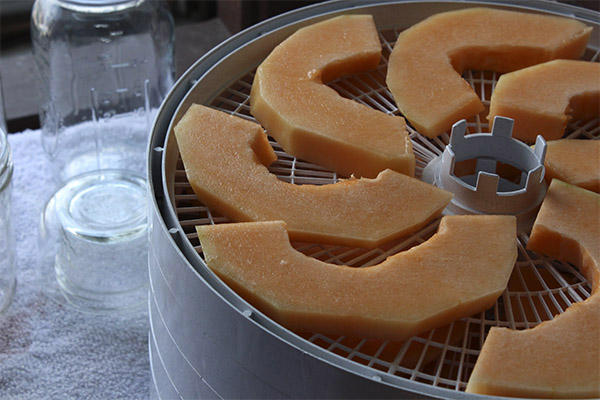
During this time, it is better to put the machine in a well-ventilated non-residential room - on a balcony, terrace, summer kitchen. During the operation of the device will intensively evaporate moisture from the melon.
In an electric dryer, the product dries completely in 8-12 hours. The result will please - the delicacy is prepared gently, without loss of taste and nutritional qualities.
In the microwave
In the microwave, you can also make a dry melon, but with this method will have to compromise. Control with pauses of 2-3 minutes is required throughout the drying process, as it is cyclical. The melon is microwaved by repeating the following operations:
- Spread the slices on a flat plate lined with a napkin. On top of the product is also covered, using paper towels.
- Turn on the "Defrost" mode for 2-3 minutes.
- Turn the slices to the other side, draining the moisture if necessary.
- Continue cooking at 100 W power for 2-3 minutes.
After each such cycle, assess the condition of the product and continue drying until the desired result is obtained, alternating between the "Defrost" and 100 W cooking modes, turning the slices each time before turning on the microwave again.
This method is the fastest and takes about 20 minutes. You can cook melon in the microwave only in small portions. Therefore, in total, drying slices of one whole fruit will take about the same amount of time as drying in the oven.
After drying in the microwave, the product is allowed to cool and then proceed to its packing and packaging.
The attitude to home preparations, cooked in the microwave, is ambiguous. Harm from the use of this device and the alleged destruction of all the useful substances in the product is not proven. However, such an extreme mode of drying gives some reduction in the taste of the melon. The slices are less flavorful than in the other cooking method.
In the sun
Cooking dried melon in the sun is the most natural way. It allows the maximum preservation of all the useful substances of the fruit, but puts the course and the result of the process in dependence on weather conditions. Therefore, it can be used only in regions with a consistently hot summer. Dry weather with temperatures no lower than 20 degrees is required for 7-14 days.
Sun-dry melon in several ways: on paper, on a sieve, on a string or wire. The result are petals or cubes of dried melon.
Paper for drying is placed on trays or sheets of plywood. Large pieces of gauze or thin cloth will also be needed. They cover the surface on which the product slices are placed, and then cover them on top to prevent insects and dust from getting on the product.
Place the melon in a single layer to dry in a warm, dry room. The product should not be exposed to direct sunlight. Leave windows and vents open for good ventilation. Change the paper liner at least twice a day and turn the slices. If these rules are neglected, the product will get moldy from the excess moisture.
Proceed in the same way when drying on a sieve. Stretch a fine mesh on a wooden frame, cover it with gauze and arrange the melon slices. The product is covered with a second layer of cloth and put out to dry. This method is less troublesome than the previous one, because it does not require replacing the substrate. The moisture will evaporate naturally.
Pieces of melon are threaded with a needle or on a thin wire. This method uses different forms of cutting - slices, double petals or cubes. Prepared in this way "beads" are hung in a dry, ventilated room. The pieces of fruit are distributed evenly so that they do not stick together.
Every day the melon on a string or wire is carefully inspected. Slices that have begun to rot or become moldy are removed. Slices of product move a little on the string or wire, so that the product does not spoil at the puncture point.
Drying in the sun takes 1-2 weeks, but it is considered the most environmentally friendly way of preparation.
If the weather conditions deteriorate suddenly, with rain and strong winds, the drying process is interrupted this way. The product is brought to readiness in the oven, microwave or dryer.
Over the hob or stove
This option is suitable as an auxiliary option, if during the preparation of any other way there were some problems and the product must be brought to the readiness.
Melon slices are placed in a single layer in a box with a mesh bottom. The container is placed over an electric or gas stove, cooking surface. On top of the box throw gauze or a thin cloth to protect the product from insects and dust and particles of debris. During cooking, warm air will pass through the mesh on the bottom and accelerate the process of evaporation of liquid and shrinkage of the product.
Depending on the intensity of use of the stove and the duration of cooking on it, drying melon in this way can take from several days to 1-2 weeks.
How to readiness
The degree of readiness of dried melon is determined by checking the slices for viscosity and bendability. You can finish the process when the slices are well dried, but not completely dry. The melon slices in this state are flexible, but not brittle, may be a little sticky from the sugar. In this state, they are stored for several months, but in the wrong conditions they can get moldy.
Completely dry slices are firm but not brittle. The surface may be slightly sticky, especially if the product was sprinkled with sugar during cooking.
The dried melon is difficult to break, but can be sliced with a sharp knife. If the process of preparation was carried out correctly, the slices retain some elasticity. To bend them, a noticeable effort is required.
A brittle and crumbly texture means that the drying process took place at too high a temperature.
How to store dried melon properly
The finished slices can be left in their original form or rolled to save space. In this form, they can be stored for about six months. A well-dried melon can be eaten for up to a year if it is properly packed.
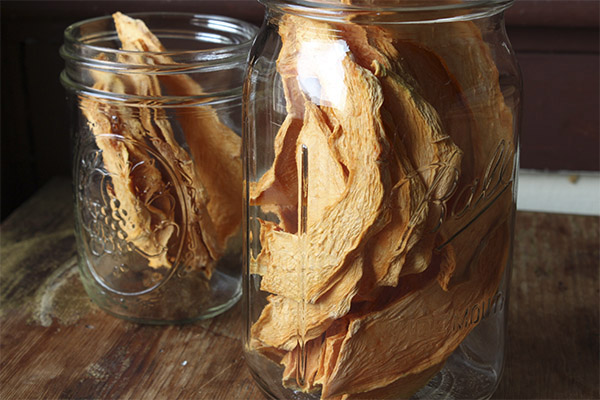
The product is very well preserved in small linen (canvas, linen) bags. The fabric provides the necessary air circulation and protects it from dust.
Paper bags are also suitable for storing dried melon. Paper is hygroscopic, so the product does not get moldy.
Both bags and sacks should be tightly closed to prevent air and moisture vapor from getting inside. Containers should be tied with string or sealed in any other convenient way. It should be foreseen that after opening or all the contents of the package will be immediately consumed in food, or there is a possibility again to hermetically close it. Therefore it is better to pack dried melon in small portions. This way it is better preserved.
You can wrap the preparation in glass jars lined with paper on the inside. This is done to avoid condensation inside. Every 2-3 months, open the container and replace the paper liners with fresh ones. Dark glass containers are not put in a dark place, because they do not let in light and provide better storage conditions for the product. But the temperature regime observed necessarily. Heating jars with dried melon is inadmissible. Therefore, they are kept away from direct sunlight.
Polyethylene bags are used for dried melon as a temporary storage option during transportation. Without the risk of being spoiled, the product can be stored in the film for a few days. After that, it may be necessary to spread it out on a horizontal surface and let it stand for a few hours to get rid of possible condensation. The dried melon is then packed in paper, textile or glass containers for permanent storage.
Sometimes rolls of dried melon are placed in individual paper packaging. We get a kind of candy. This method is suitable only for short-term storage, since there is no way to check the preservation of the product.
Regardless of the method chosen, store dried melon in a dry, dark place, protecting it from direct sunlight and ensuring good ventilation. As with other dried supplies, sources of strong odor near this product should be avoided.
Periodically inspect the stock 1-2 times a month. Rotten, moldy, or insect-infested slices are removed. If at least one spoiled slice is found, the entire stock must be thoroughly reviewed.
If the next check shows that the dry slices have become dried, flexible and elastic, it is necessary to put them out again for the prophylactic drying. And the container in which the product was stored should be checked for tightness.
Duration of storage depends on the temperature in the room. In a cellar, basement and refrigerator, where it is never warmer than 10 degrees, dried melon is stored for up to 15 months, subject to regular checks for mold and other damage.
At room temperature, it is recommended to consume the entire stock in the first 6-8 months, and use the rest of the stock as dried fruit and subject it to heat treatment. Dried melon is suitable for making compotes, as a filling for baking, in sliced form is an excellent substitute for raisins and candied fruits.
In conditions of high temperature (more than 30 degrees) and high humidity, dried melon is stored for no more than a month.
What are the benefits of dried melon
Thanks to the evaporation of moisture while maintaining the fibrous structure, dried melon slices have even more useful properties than fresh products. Cooked in this way the queen of melon is a valuable source of vitamins and fiber. Dried melon is used as a choleretic, diuretic and immune stimulating agent. It is good as a light sports snack for recuperation after physical exertion.
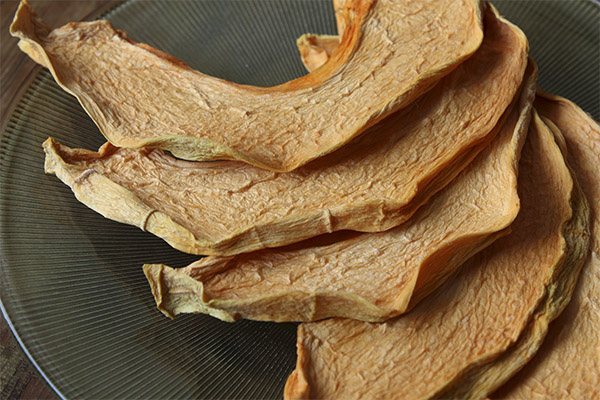
- Melon is rich in natural antioxidants, so its consumption activates the restorative processes in the body and improves the overall health. Biologically active substances and fiber, which are rich in this product, start the process of natural tissue rejuvenation. The regular consumption of dried melon improves skin condition, it becomes smooth and velvety. This effect is associated with a beneficial effect of this product on the gastrointestinal tract. It stimulates intestinal peristalsis and activates the digestive processes. A few slices of dried melon will solve the problem of constipation and increased gas formation (flatulence).
- The melon also has a beneficial effect on the liver, helping to restore its cells. This product is included in the diet of patients with hepatitis, cholecystitis.
- The consumption of dried melon slices is very useful for people with diseases of the cardiovascular system, with anemia, atherosclerosis, vascular disease. Iron, which is rich in this product, improves the transport of oxygen in the blood, helping to increase hemoglobin levels. Regular consumption of melon lowers cholesterol levels and reduces the risk of heart attack and stroke.
- It is good to include this product in the diet of expectant mothers. This is a valuable source of folic acid, which is necessary for the health of the baby and is contained in a very limited set of products.
- This treat can be given even to small children, the product is hypoallergenic. It will be an excellent alternative to sweet confectionery, especially since, unlike candy, dried melon is a valuable source of vitamins and trace elements necessary for the growing body. In order to make it easier for the baby to bite into pieces, the dried fruit can be put on boiling water.
- This product is also useful for older people. As a rule, with age, many of the body systems begin to fail, chronic diseases accumulate. The delicacy of the southern melon has a beneficial effect on almost all organs, provides vitamins, gives strength and improves the mood. No wonder that in the East and the Caucasus, where melon is a common product, there are so many long-livers and people keep active and in good spirits until very old age. But from eating this delicacy should be refrained from people suffering from diabetes.
- The set of vitamins contained in melon pulp is optimal for supporting the nervous system. Vitamins A, P, C have a beneficial effect on a person's emotional state. A few slices of this product in dried form act as a mild sedative.
- Very good melon during rehabilitation after infectious diseases, especially if the therapy was carried out with antibiotics. This product stimulates recovery from viruses, strengthens the immune system.
- Due to a high concentration of sugars, dried melon improves the mood and the emotional background. It is a natural antidepressant that can be eaten as a snack, an ingredient for baking, a flavoring agent for tea.
- The sugar content of the product has a beneficial effect on brain activity and activates it. Therefore, dried melon is an excellent addition to the diet of students, a valuable product in conditions of high intellectual stress and stress.
- Despite the fact that the treat is very sweet, it is able to quench the feeling of thirst.
Note that this product does not go well with fermented dairy products. It is generally better to eat it as a separate treat.
«Important: All information on this site is provided for informational purposes only. purposes. Before applying any recommendations, consult with a specialized specialist before you use any of the recommendations. Neither the editors nor the authors shall be liable for any possible harm caused by materials."


